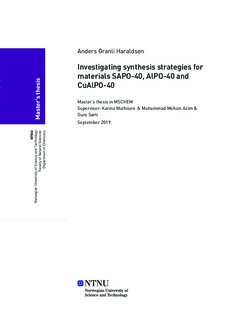| dc.contributor.advisor | Mathisen, Karina | |
| dc.contributor.advisor | Azim, Muhammad Mohzin | |
| dc.contributor.advisor | Sørli, Guro | |
| dc.contributor.author | Haraldsen, Anders Granli | |
| dc.date.accessioned | 2019-11-01T15:00:28Z | |
| dc.date.available | 2019-11-01T15:00:28Z | |
| dc.date.issued | 2019 | |
| dc.identifier.uri | http://hdl.handle.net/11250/2626173 | |
| dc.description.abstract | Målet med denne oppgaven var å undersøke syntesestrategier for fremstilling av materialene SAPO-40, AlPO-40 og CuAlPO-40, materialer i AFR zeotyp systemet. På grunn av materialenes unike poresystem, potensiale for høyt overflateareal og høy hydrotermisk stabilitet, så blir AFR systemet ansett som en god kandidat for utvikling av nye katalysatorer.
Materialene som oppgaven omhandler er, så langt forfatter kjenner til, mindre representert i litteraturen sammenlignet med andre zeotyper som SAPO-34 og SAPO-11, og det er et stort ukjent territorie i bruken av disse materialene i katalyse. SAPO-40 og AlPO-40 har begge blitt rapportert syntetisert, mens CuAlPO-40 er et helt nytt materiale.
Ingen synteser fra litteraturen kunne reproduseres i nevneverdig grad. Av alle syntesene som ble undersøkt, var metoden fra Sierra, L. et al. den mest lovende.
Ulike fysiske of kjemiske parametere ble undersøkt. En prøve ga SAPO-40 som den mindre fase, tilsynelatende tilfeldig. Ingen parametere som ble undersøkt så ut til å promotere SAPO-40.
For AlPO-40, ble flere kristiske parametere identifisiert. Reaktoren reaksjonen skjer i, må vaskes med konsentrert flussyre (HF) for å fjerne spor av kontaminerende biprodukter som kan katalysere krysallering av feil produkt. Vanninnholdet i gel-en ble også bestemt som en kritisk parameter. Ved reduksjon fra 37,5 til 32,5 molare ekvivalenter vann, som reduserte pH til ca. 6, så ble en prøve hvor AlPO-40 var eneste krystalline fase oppådd. Diffraktogrammet hadde også brede, uidentifiserte topper, som tydet på at prøven ikke var fullstendig faseren. Krystallisasjontid ble også identifisert som en viktig parameter. Ved økning i tid, så ble mer krystalline prøver, med lavere kontamineringsgrad, oppnådd.
Den mest lovende AlPO-40 prøven ble kalsinert og overflate arealet ble undersøkt. Arealet ble funnet til å være på 528 m^2/g hvorav 378 m^2/g kunne attribueres til mikropore-arealet.
Til slutt, faseren CuAlPO-40 ble ikke oppnådd, men en prøve hvor AFR fasen var største fase ble oppnådd. Prøven var blå i sin tillagde tilstand og endret farge til mer grønnlig etter kalsinering, noe som tyder på vellykket rammeverks-inkorporering. Videre tester er nødvendig for å bekrefte dette. | |
| dc.description.abstract | The aim this thesis was to investigate synthesis strategies for materials SAPO-40, AlPO-40 and CuAlPO-40, materials belonging to the AFR zeotype system. With a uniquely shaped pore system, potential large surface area, and high hydrothermal stability, the AFR system is a prime candidate for the development of new catalysts. Combining these capabilities with the catalytic power of copper substituted into the framework of zeotypes, made the materials exciting, potential catalysts.
These materials are, to the extent of the author's knowledge, less represented in reported literature when compared to other zeotypes such as SAPO-34 and SAPO-11, and there is a large uncharted territory when it comes to using these materials in catalysis. Both SAPO-40 and AlPO-40 have reportedly been synthesized, while CuAlPO-40 is a completely new material.
No synthesis reported in literature for neither SAPO-40 nor AlPO-40 could be reliably reproduced. Of all the investigated synthesis sources, the AlPO-40 synthesis from Sierra, L. et al was the most successful.
Various physical and chemical parameters were investigated. SAPO-40 was obtained once as a minor phase, though seemingly randomly, and no parameter was found to influence its formation.
For AlPO-40, it was found that washing the liners with concentrated hydrofluoric acid (HF) in order to remove contaminants that could seed byproducts was crucial in order to obtain the desired phase. The water content of the gel was also found to be of upmost importance. Lowering the water content from 37.5 molar equivalents to 32.5, thus lowering the pH to about 6, succeeded in producing a sample where AlPO-40 was the only crystalline phase present. There were some broad peaks in the diffractogram however, indicating that it was not phase pure still. The crystallization time was also found to be important for the crystallization of AlPO-40, with longer time values producing more crystalline and less contaminated samples.
The most promising AlPO-40 sample was calcined and the total surface area was determined to be 528 m^2/g of which 378 m^2/g could be attributed to the micropore area. This value was comparable to other, commercialized zeotypes such as SAPO-5.
Finally, phase pure CuAlPO-40 was not obtained, but a sample where the AFR phase was the majority phase was obtained. The sample was blue in its as-prepared form and turned a greenish colour upon calcination, possibly indicating successful framework incorporation of copper, but further tests would be needed to confirm this. | |
| dc.language | eng | |
| dc.publisher | NTNU | |
| dc.title | Investigating synthesis strategies for materials SAPO-40, AlPO-40 and CuAlPO-40 | |
| dc.type | Master thesis | |
